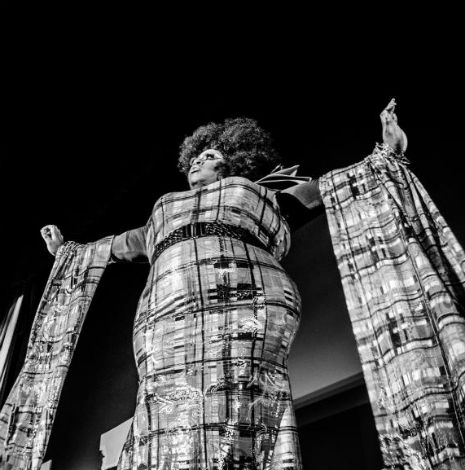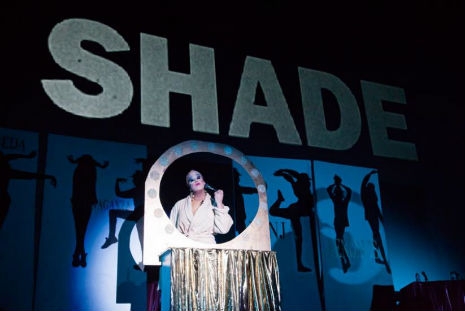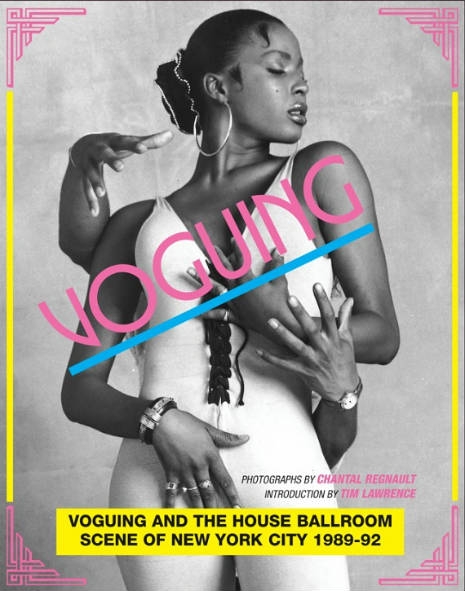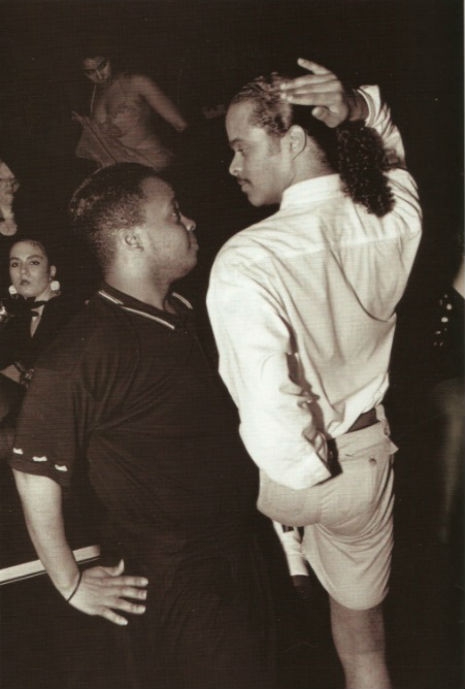
Latrice Royale onstage at The Castro Theatre, photo by Robby Sweeny.
NOTES FROM THE NIALLIST
If you have not seen Paris Is Burning, you’re just not doing it right. I’m talking Life, honey.
I’ve written about Paris Is Burning before, and referenced it in my recent ballroom piece for Boing Boing, but the truth is that the impact of this film on gay culture, and by extension culture at large, cannot be overestimated. That a film about underground drag culture and voguing resonated so strongly amongst gays should not be a surprise, but what is surprising is how far its influence has spread in “straight” circles. Its language and imagery are now common parlance, and it won a recent PBS “best documentary” poll by an overwhelming landslide.
Which is why I was so delighted to see Paris Is Burning get recent a Midnight Mass screening in San Francisco, hosted by the queens Peaches Christ and Latrice Royale. Barring stars of the film itself (most of whom have sadly passed) I could not think of a better pair to present it. Peaches Christ is a legendary San Francisco performer and the regular Midnight Mass movie hostess, and is so obsessed with films, ickiness and camp that her boy alter ego, Joshua Grannell, recently directed the future-cult-classic All About Evil, starring Natasha Lyonne, Mink Stole and Elvira. Latrice Royale, meanwhile, was a competitor on last year’s season of RuPaul’s Drag Race, and through a combination of straight-talking and motherly warmth, went on to win the show’s “Miss Congeniality” prize, and has become one of the most popular contestants that Drag Race has ever seen.
I couldn’t waste this opportunity to ask two legends of drag about this legendary drag film, so I sent them both a set of questions to answer.

Peaches Christ and Latrice Royale
THE NIALLIST: When did you first discover Paris Is Burning?
LATRICE ROYALE: I believe it was 1995.. I know a little late, but again I was very new to the lifestyle at this time in my life.
PEACHES CHRIST: I was a junior in high school and the movie was such a huge indie hit in the urban markets that Miramax did a wide release, which meant it played at the local Maryland mall where I grew up. I remember going to see it with my closeted lesbian friend and my hands were literally shaking when I went to purchase a ticket—I was a closeted queen and was terrified someone would see me buying a ticket to the movie—that my secret would be revealed. I watched it wide-eyed and in awe and while there is clearly a tragic element to the film, especially ending with Venus’ murder, I found it to be inspiring, creative, loving, and it really showed me that there was a way people like “us” could find a family, create a world for ourselves, and that the world could be imaginative, unique, and FABULOUS. I went to see it three more times in the theatre and each time I did, my hands shook a little less when I bought a ticket.
TN: What kind of an impact has it had on your career, and how has it influenced you personally?
LR: Well from my own personal experience in life, I totally could relate to these young kids. As I was one of them. I was too scared to come out after being outed by my brother. But I did learn that you could rebuild your family with people to your liking.
PC: I kind of feel like there are two drag worlds- the one pre-Paris Is Burning and the one post-Paris Is Burning, because after the movie came out and was widely distributed, queers sought it out, understood it, embraced and appropriated its culture on all levels of queer culture. It’s effect on our language, style, dance, etc. can not be underestimated. Whether people know it or not, it changed queer culture and then of course popular culture because it’s my belief that most of the best parts of popular culture start with the queers.
TN: How do you feel time has treated the film?
LR: Knowing what I know now, and seeing how bullying is such the trend.. We need to have a world wide revival of this movie. So many are unaware of a crucial part of our history.
PC: I watch it today and am again- blown away by how much of everything we do and saw comes from this seminal film. It’s timeless.
TN: What would you say to younger queens who haven’t seen the film?
LR: Well as I stated earlier we need a revival!! Our youth should be aware of just how far we’ve come, while realizing we still have so much further to go. But with knowledge comes power, and hopefully our youth will learn that they too, have a voice.
PC: It’s a must see of course. Completely required viewing. I’m actually teaching a class in 2014 at the SF Art Institute that’s essentially “Drag In Cinema” and I’m building the course around this film.

Peaches Christ as Dorian Corey, photo by Nicole Fraser-Herron
TN: Who is your favourite character in Paris Is Burning?
LR: Pepper LaBeija LEGENDARY MUTHA!!
PC: I can’t choose one- seriously. I’m obsessed with Dorian Corey, Willi Ninja, Pepper LaBeija, Venus Xtravaganza, and Octavia St. Laurent. I love them all.
TN: Peaches, could you tell us about the process of getting Paris Is Burning to the big screen again?
PC: I’ve wanted to do a Peaches show around Paris Is Burning for years and years but really needed to do it the right way and create a show that felt authentic- so it took some time but I was able to seek out members of the West Coast ball scene who came on board to create the show with us. I reached out to Latrice because I really feel like she embodies the true spirit of the film—inspiring a new generation of queens to perform with style and grace, understanding their history while also serving it to audiences—making them eat it. I have been in touch with Jennie Livingston, the film’s director, and she’s been so supportive and WONDERFUL and we’ve been talking about how this Paris Is Burning zeitgeist will hopefully lead to more projects, more longevity, more celebration, and that this community’s legacy will live on forever.
TN: And finally, Latrice, how was the Paris Is Burning Midnight Mass screening?
LR: I must say the whole experience working with Peaches Christ was one thatI will never forget!!! So brilliant, and such an honor to be apart of more history in the making.
TN: History indeed!
To end, here’s another bit of history, the original 1991 TV trailer for Paris Is Burning, complete with that guy doing the voice-over:
For more info, and to view the picture gallery of images form the screening, visit PeachesChrist.com.
Previously on Dangerous Minds:
Paris Is Burning: Vogue Realness
Dorian Corey: the drag queen had a mummy in her closet
Dream Queens: ‘Voguing And The House Ballroom Scene Of NYC 1989-1992’
Deep In Vogue: an introduction to ballroom and modern voguing culture
Octavia St Laurent and the legends of voguing want you to ‘Be Somebody’










